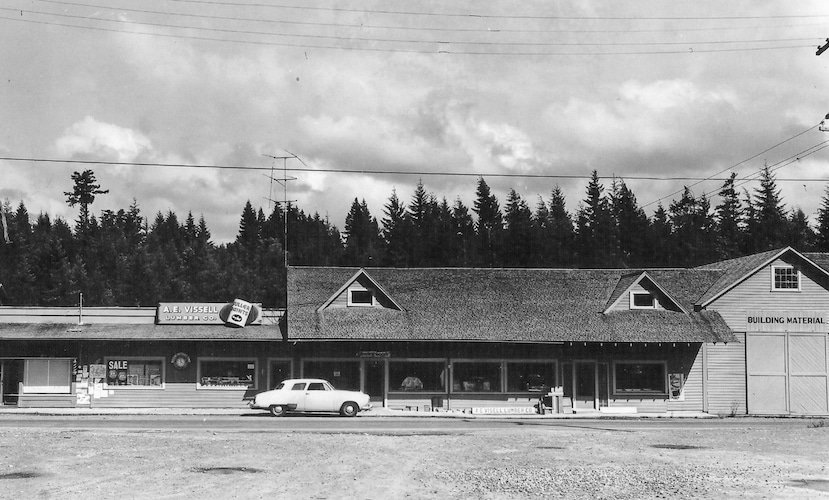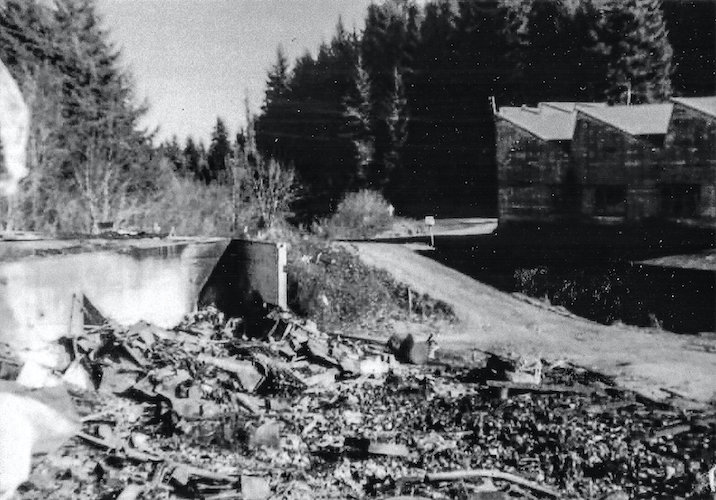The scene of the fire in the early morning, looking up from the bottom of the gully towards the gas station across the intersection. Photo: Bob Boxberger, collection of Nadine Niemann.
Fifty years ago, in the early morning hours of Feb. 4, 1970, a fire of unprecedented proportions burned through several businesses in Key Center, leaving only ashes and charred rubble in its wake. Nothing was left of the complex, originally built in 1932, that housed a grocery store, meat lockers, a state liquor store, a lawyer’s office, and a hardware and building materials store.
It was the end of a long chapter in the history of Key Center, a chapter that had been started by Alden E. Visell and Elmer Olson almost 40 years earlier.
Until the 1930s the Key Peninsula was known as the Lower Kitsap Peninsula or the Longbranch Peninsula. In 1930, Visell and the area’s Business Men’s Club offered $50 in prizes in a naming contest, hoping that a new name would give the peninsula its own identity and make it easier to promote. The results were announced in early 1931: The winning entry was “Key” by E. M. Stone of Lakebay, a name inspired by the peninsula’s resemblance to an old-fashioned skeleton key. Second place went to Doris Bolton of Vaughn for “Arcadian,” while Nelson Peck, also of Vaughn, earned third place for “Pensylvia.”
The name Key Peninsula caught on, although it would not be officially recognized by the state’s Board on Geographic Names until 1980 and by the U.S. Board of Geographic Names in 1981.
Villages and towns have always needed a central marketplace to grow around. The peninsula was not going to be an exception. Key Center, its business hub, soon came into being and was inaugurated the following year. “Key Center is Opened to Public” read the headline in the March 12, 1932, edition of the Tacoma Daily Ledger: “New Business Center on Peninsula Has Many Modern Stores.” Located at the intersection of the highway and the road connecting Vaughn and Glencove, the new development included a service station, Visell Lumber & Hardware Co., owned by Alden Visell, a radio and electrical store, a drug store, a coffee shop and a grocery store “with the most modern fixtures,” to be operated by Chester and Leah Hipp.
The 300-foot long complex occupied the southeast corner of the intersection on land that Visell owned. Customers parked in front of the store or in a parking area across the highway. A gully, 15 to 18 feet on average below street level, dropped off behind the building. The back of the store was built on stilts. A road down the gully was used for loading and unloading merchandise from below for the stores above.
By the late 1960s the grocery and the hardware store, the primary businesses in the complex, had changed hands. Italian-born Dominic Marietta was the new owner of the grocery, now called Dominic’s Foods; a state liquor store was added. Marietta was also a butcher who dressed, cut and wrapped game for hunters, and provided freezer space in the store’s meat lockers.
Libby Rittenhouse, Marietta’s stepdaughter, remembered Dominic as a man with “a big heart,” always ready to extend credit or help customers home with their groceries. According to Tim Kezele, Dominic was cheerful, never without a big smile. “He always wore a white dress shirt, old country-style. And he loved his ’48 Cadillac,” Kezele said.
By then the owner of Visell Lumber & Hardware was Ken Brones, who kept the name of the business. Brones, who had grown up in Vaughn, was “a friendly and honest man,” according to his nephew Norman Brones, “always with an inner calmness and poise that people found comforting. He had a sense of community and was a great listener to all his customers.” 
Visell's Lumber & Hardware store in the 1960s. Courtesy Key Peninsula Historical Society
By all accounts Marietta and Brones were the mainstay of the Key Center community. Brones was sometimes referred to as the mayor of Key Center. “Those were fun times in the village,” Norman Brones recalled.
Ken Brones also bought Visell’s house and the rest of his property, which stretched about a half a mile south of Key Center.
It was in that house, from her north-facing upstairs bedroom window, that Ken Brones’ teenage daughter Nadine first saw the glow of the store on fire at 3 a.m. Feb. 4, 1970.
“I wore curlers in my hair and they were bothering me,” Nadine said. “I woke up and I saw the sky was orange. So, I went to the window, looked out and saw the flames. As fast as I could get down the stairs I went and told Dad. He woke up, got dressed, put on his boots and away he went.” Nadine then called the fire department, the first person to do so that night. Fire District 16, then headquartered in Wauna, sounded the alarm. 
Rubble at the bottom of the gully the morning of the fire. On the right, the woodworking and boat repair shop, today The Landing. Courtesy Key Peninsula Historical Society
Don Mills, at the time also a volunteer fireman, immediately responded from Vaughn Bay. Mills’ wife Judy remembers the call coming over the Plectron, a device on their phone that was used to call the firemen. “I don’t think I’ve ever seen Don move so fast,” she said.
Mills rushed up to the fire station, a cinderblock building a few hundred feet up the road to the east. “The tanker truck had a dead battery, so I had to roll it out of the station to get enough momentum to get it started,” Mills would later recall. Fighting the blaze was not going to be easy.
Don Olson, another volunteer fireman, lived across the highway southwest of the burning building. Awakened by the roar of the flames, he ran out of the house and saw the fire, which at that time was burning only in the middle of the building at the center of the hardware store. The flames hadn’t yet reached the grocery store at the north end of the building or the lumber store at the south end. By the time responders and equipment arrived at the scene the fire had spread to the entire building. Paint cans in the hardware store were exploding, something that Joyce Niemann remembered hearing at Sunnycrest Farm up the hill from Key Center. 
Key Center a year before the fire. Photo: USGS acquired via HistoricAerials.com
Fred Ramsdell, who responded from Home, recalled that the heat was so intense the Shell sign at the gas station diagonally across the intersection from the fire had melted. Whatever water was available was used to save burning utility poles and nearby buildings, where paint had blistered and peeled in the heat. Water used on the heat mass of the fire would have been wasted.
The fire burned for several hours; the building was completely destroyed. Nothing was left of Visell Lumber & Hardware, Dominic’s Foods, the liquor store and meat lockers, the law office of attorney Wayne Knight, which occupied a narrow space between the two stores, or a small apartment under the grocery. Key Center as the community had known it for almost 40 years had ceased to exist.
At 5:30 a.m. Pierce County Fire District 16 Chief Medric Schwenka, suspecting arson, phoned the state fire marshal’s office to report the incident and request an investigation. When two fire marshal deputies arrived at the scene shortly after 10 a.m., they found the building completely destroyed, with pits of smoldering fire in the gully. According to the report the cause of the total loss was “delayed discovery and exposure hazards together with limited water supply.” The report estimated that the fire had started around 1 or 2 a.m., burned for approximately 10 hours and reached a maximum temperature of 1,800 degrees.
The total losses to the grocery store and the hardware and lumber store were estimated at $200,000, about $1.3 million in today’s dollars. Both businesses were underinsured. "Ashes and rubble are all that remain."
A stunned community gathered at the site of the fire over the next few days to take in the loss. The morning of the fire Don Olson’s daughter Claudia arrived from Sun Valley with Dale Loy, her future husband, “to show Dale my hometown,” as she later said. Instead what Loy saw across from Claudia’s parents’ house was an enormous hole in the ground. The fire was front page news in The News Tribune and The Peninsula Gateway on Feb. 5. “Fire Flashes Through 2 Key Center Firms; Just a Hole in the Ground Remains,” was the headline in the Tribune. “Disastrous Fire Strikes Key Center,” reported the Gateway. “Ashes and rubble are all that remain.”
The fire marshal’s report concluded that the origin and cause of the fire could not be determined. “The loss of this complex may be a result of vandalism or arson," the report said. "There is no evidence at this time to indicate this, however. Cause and origin must remain as unknown until further evidence is found pending the investigation.” Two juveniles were reportedly seen in the laundromat across the highway before and during the fire, but they were never identified. Key Peninsula News has been unable to locate any additional reports or records of arrests at the state and county archives or in the local press.
As early as 1967, work had begun filling in the slope of the gully opposite the store. After the fire the work accelerated, and the hole left by the fire was soon filled in. By 1971 planning for a new shopping center was underway. A new station for Fire District 16 opened in 1973 at its current location in Key Center.
The state fire marshal’s report on the Key Center fire, obtained from the Washington State Archives, is available here.
McDermott Point lighthouse. Photo: private collection
A fire destroyed the abandoned lighthouse at McDermott Point at the entrance to Filucy Bay after midnight Feb. 4, shortly before the fire in Key Center. Not an official lighthouse recognized by the Coast Guard, the structure had fallen into disrepair. A neighbor saw a flash in the building at 9:45 p.m., which later was interpreted as suggesting the use of an accelerant. After midnight reports came in of a fully engaged fire. The fire marshal’s report includes an account of this incident, concluding that although it may have been a diversionary tactic intended to draw resources away from the fire at Key Center later that night, no evidence to that effect was found. No equipment was sent to fight the lighthouse fire since the site was not easily accessible by land and as an abandoned structure the fire did not pose a danger.
UNDERWRITTEN BY THE FUND FOR NONPROFIT NEWS (NEWSMATCH) AT THE MIAMI FOUNDATION, THE ANGEL GUILD, ADVERTISERS, DONORS AND PEOPLE WHO SUPPORT INDEPENDENT, NONPROFIT LOCAL NEWS